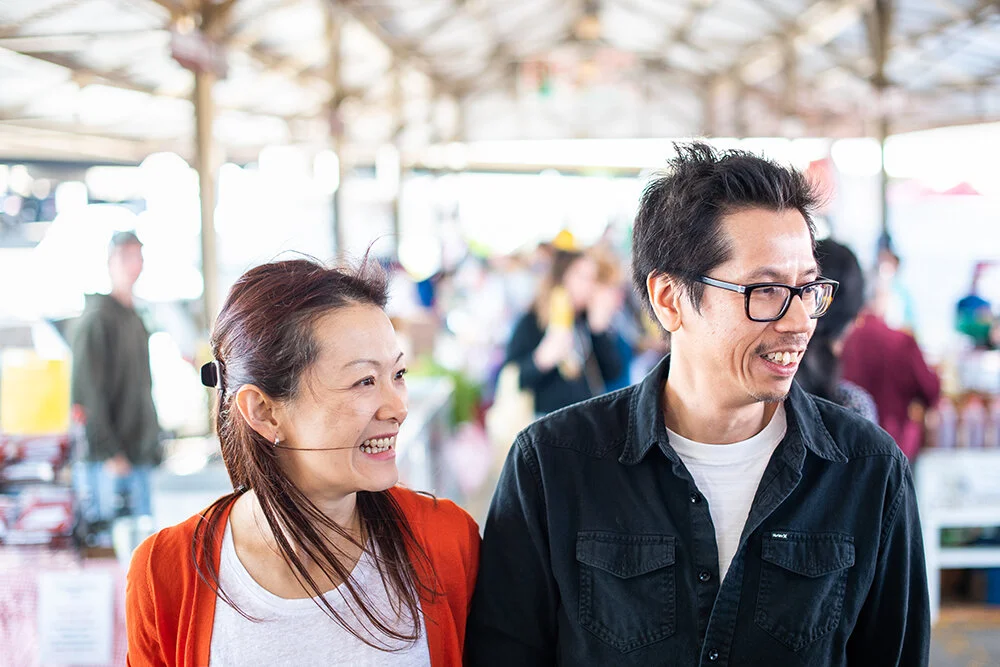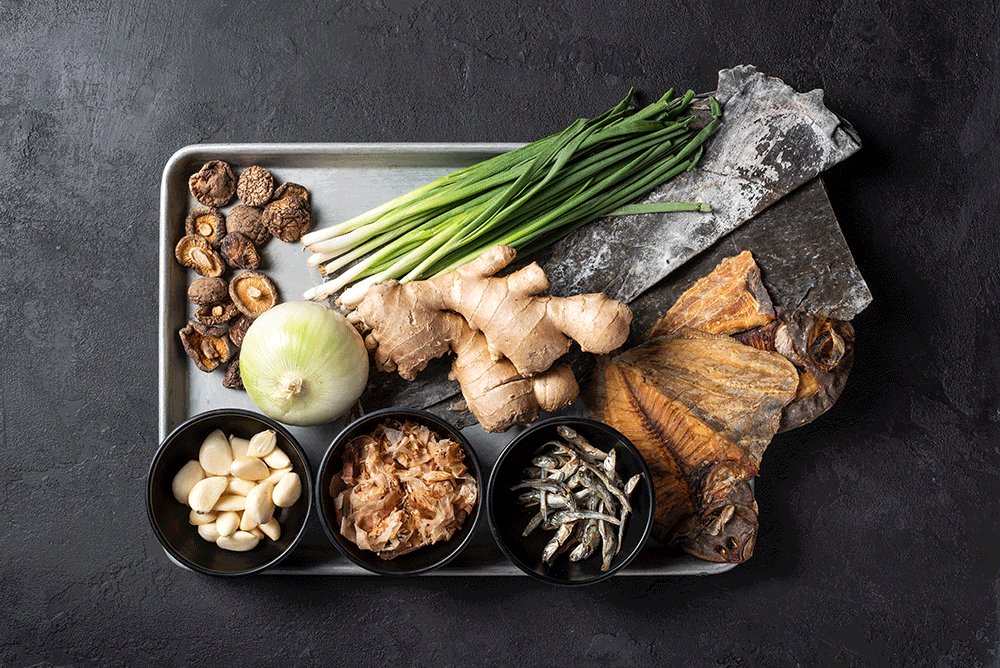John Ng of Zen Box Izakaya in the kitchen preparing an assortment of ramens // Photo by Kevin Kramer
The Ramen Architect
October 29, 2018 by James Norton
John Ng of Zen Box Izakaya is a designer, engineer, and builder (of soup)
If he weren’t a chef, John Ng of Zen Box Izakaya might be a kung fu master. This is literally true: the architect-turned-izakaya co-owner has been practicing martial arts for 16 years, having begun his training while living in San Francisco. “When I first came to Minnesota, I told my wife [Lina Goh]: ‘I really want to open my own kung fu school.’” Ng summarizes her brutally practical response: “I got immediately shut down by her, because ‘it would never make any money! Forget it!’ Which is pretty true,” he laughs.
The couple instead started a successful Minneapolis skyway bento restaurant called Zen Box, which opened in 2004 and closed 11 years later. In the interim, they started a more ambitious place: their current restaurant, Zen Box Izakaya, which opened its doors on Washington Avenue in 2011. Lunchtime bento boxes had been getting monotonous, and the pressure to succeed kept the couple curious about what a bigger, stand-alone restaurant could become. For Goh, a lot of that drive started at home.
“My mom and dad almost disowned me; it was typical Asian tiger parents,” says Goh, who left a career as a corporate manager to dive into the world of food. “You’re expected to go to college, get a degree, work a corporate job or be a doctor. Don’t do restaurants! […] But we stuck with it.”
If there’s a theme to Ng and Goh’s success with Zen Box, it might well be “sticking with it.” Ng’s ramen has become known as some of the best in an increasingly active and serious Minnesota noodle scene, something that wasn’t always the case. “I was his toughest critic,” says Goh. “I was like, ‘John, this is not good, but we have to keep going because it’s a business. Let’s try a different way.’”
Lina Goh and John Ng at the downtown St. Paul Farmer’s Market // Photo by Kevin Kramer
Ng has applied the focus and repetition required in kung fu to his work as a chef, forging and reforging his ramen recipes obsessively, always looking to perfect the process, the ratios, and the final balance of flavors that fill each bowl. Part of the learning process has involved hosting notable ramen chefs (the restaurant’s annual Ramen Attack! series); and part of it has been visiting Japan, every other year or so, talking with chefs and obsessively chowing down on bowls of ramen that can inspire their Minneapolis menu. Their record is eating 25 bowls of ramen in eight days.
“John self-learned,” says Goh of her husband’s progress as a chef. “Our test kitchen was the skyway location. [When] we got […] Yelp reviews, we’d take them. We tasted ourselves; we were so hard on ourselves. He has come a long way. Taking that constructive criticism and not taking defeat from it—it really helps,” she says.
From sketchbook to bowl
Before he was a chef, John Ng was a San Francisco–based architecture project manager. Over the course of seven years, his work varied from commercial design (think Gap Inc. storefronts) to residential remodeling. “I pretty much got burned out—not because of the architecture itself, but the frustration of dealing with the city,” Ng says.
Ng’s approach to cooking borrows more than a little from his previous vocation. Ng fills notebooks with sketches, splashing ingredients, plating directions, and notes on the structure of his food across the page. Zen Box has become well-known for its ramen, but the izakaya also does everything from rice bowls to Japanese-style fried chicken to a killer tuna poke bowl (recipe at the end of this story).
Ng’s sketchbooks // Photos by Kevin Kramer
If the rigorous planning and organization of architecture laid the groundwork for Zen Box’s ramen program, Ng’s training in the repetitious-yet-conscious practice of kung fu gives it staying power. “Every day is quality control, making ramen,” says Ng. “Every day you have to make the broth. How can you make the broth consistent, so every time you present it to your customer it will have the same texture, the same thickness, the same structure as before? It’s a boring job. You do it every day. But what you’re ultimately looking for is when the customer finishes the whole bowl and gives you a thumbs up. That’s what you gain ultimately.”
Ng is an architect who conceptualizes each bowl of ramen with careful consideration of flavor, texture, and process. He’s also the engineer who has to build the bowl—considering how a specific noodle might hold up in a specific broth, for example. And he’s the guy who has to get things done, too—the contractor, if you will.
“In a sense, food design and product design and architecture share a common goal to me—it’s all a lot of trying out, discovering, and learning the basics, and the process behind it, too,” says Ng. “Ultimately my goal is to keep trying out and see how far I can go in terms of artisan ramen.”
Ingredients Ng uses to make various ramens // Photos by Kevin Kramer
Ng’s quest for new ingredients and techniques is creatively supported (and pragmatically constrained) by Goh, his partner in both life and business. “I come into the part of being the project manager who controls the costs,” she says, playing off the architect / engineer / contractor metaphor. “He has a lot of crazy ideas, and I’m like, how much is this going to cost?”
The proof is in the eating
Tonkotsu ramen // Photo by Kevin Kramer
All of Ng’s stories wouldn’t mean a lot if the ramen didn’t support the storytelling. But, as we’ve known for years and as we tasted during our interview and photo shoot, it does. His shoyu ramen is clean, delicate, and silken—a balanced, soothing broth that builds in terms of flavor and impact as you eat it. The noodles, made with egg yolks, are kinked, springy, and delicately chewy, a lovely complement to the mellow overall
composition of the dish.
And the Zen Box tonkotsu ramen is everything you’d want from a hearty bowl of this big-spirited stuff: unctuous in flavor and texture, salty without being abrasive, and crowned with a tender, savory piece of char siu-style pork belly. The hakata noodles embrace the rich broth, and convey its deep flavor directly from the bowl to the palate.
Both bowls have the depth that ramen-seekers adore—a sense of multidimensional umami that you can lose yourself in.
Zen Box Izakaya isn’t the biggest Japanese restaurant in the state, and it’s not on the verge of franchising or world-wide fame. But for Ng and Goh, their very existence—working day in and day out to bring their customers a taste of something made with artful care—is the victory they’ve been searching for.
“Everything becomes very simple in that sense,” he concludes. “No matter what you do in life, it’s run on the same principle. If you’re being truthful with yourself and you’re always educating yourself and you’re willing to sacrifice a little to make a better society, you are successful. You don’t have to have a million dollars.”
Ramen 101: A Glossary
Char Siu: A traditional Cantonese preparation of barbecued pork, typically bright red, shiny, sweet via honey and/or hoisin, and deeply spiced.
Dashi: A simple, briny-flavored stock generally made from two or three ingredients including konbu and katsuobushi.
Izakaya: An informal Japanese pub, also a shorthand for Japanese pub grub—grilled skewers, edamame, fried chicken, and more.
Katsuobushi: Dried bonito or skipjack tuna, used to infuse flavor into ramen’s constituent broths.
Konbu/Kombu: Dried kelp deeply flavored with glutamic acid, which enhances savory flavor and helps creates a taste known as “umami.”
Mirin: A sweet Japanese rice wine that brings mild acidity to food.
Miso: A seasoning paste made from fermented soybeans, salt, and other ingredients such as rice or barley. Often used as a soup base. Miso ramen is usually a heavier, more substantial dish than either shio or shoyu ramens.
Mizuna: Japanese mustard greens.
Ramen: A Japanese soup combining broth, noodles, and additional ingredients of varying complexity. Many ramens involve fermented, marinated, or otherwise prepared ingredients that add to their depth and time of preparation. For those interested in diving deep, classification of ramens can be done by heaviness of the dish, then soup base ingredients, and then by seasoning source.
Tare: The thick base component that drives the flavor of the broth that fills any given bowl of ramen.
Tonkotsu Ramen: Ramen made with a pork-based broth, not necessarily exclusive of other ramen varieties (i.e. you can and do see Tonkotsu ramens flavored with salt or shoyu).
Umami: The so-called fifth flavor (along with sour, bitter, sweet, and salty), sometimes described as an earthy, savory depth.
Shio Ramen: A light, sea salt-based ramen.
Shoyu Ramen: Soy sauce-based ramen.
■ ■ ■
Recipe for Tuna Poke
Ingredients
4 ounces ahi tuna
Avocado, one half
1 tablespoon lemon juice
1 teaspoon sea salt
1 cup mizuna greens
Poke Dressing
1 tablespoon Japanese soy sauce
1 teaspoon rice vinegar
1 teaspoon lemon juice
1 tablespoon mirin
Directions
Slice your ahi tuna into thin slices. Combine scooped avocado, salt, and 1 tablespoon lemon juice in a blender and blend to puree. Whisk together rice vinegar, mirin, soy sauce, and lemon juice to create dressing, toss with tuna to coat. Plate avocado puree topped with greens topped with carefully arranged slices of dressed tuna.





